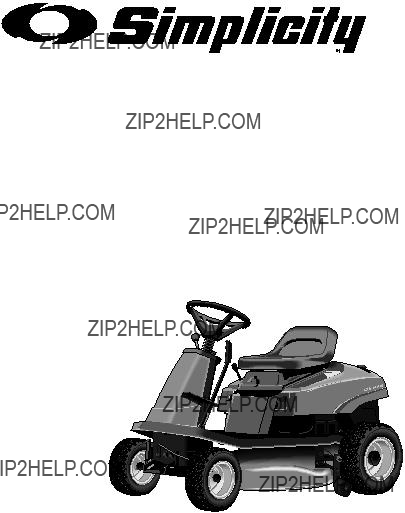
OPERATOR???S
MANUAL
Coronet
13HP Hydro
Coronet Series
1717739 Rev 4/97

OPERATOR???S
MANUAL
Coronet
13HP Hydro
Coronet Series
1717739 Rev 4/97

M A N U F A C T U R I N G , I N C . 500 N Spring Street / PO Box 997 Port Washington, WI
www.simplicitymfg.com
?? Copyright 1997 Simplicity Manufacturing, Inc. All Rights Reserved. Printed in USA.

OPERATOR???S
MANUAL
400 Series
Riders
Mfg. No. Description
1693042 411G, 11HP Gear
1693044 412H, 13HP Hydro
1693046 414H, 14HP Hydro
Mower Decks
Mfg. No. Description
1692544 30??? Mower Deck
1692546 34??? Mower Deck
1717740 Rev 4/97
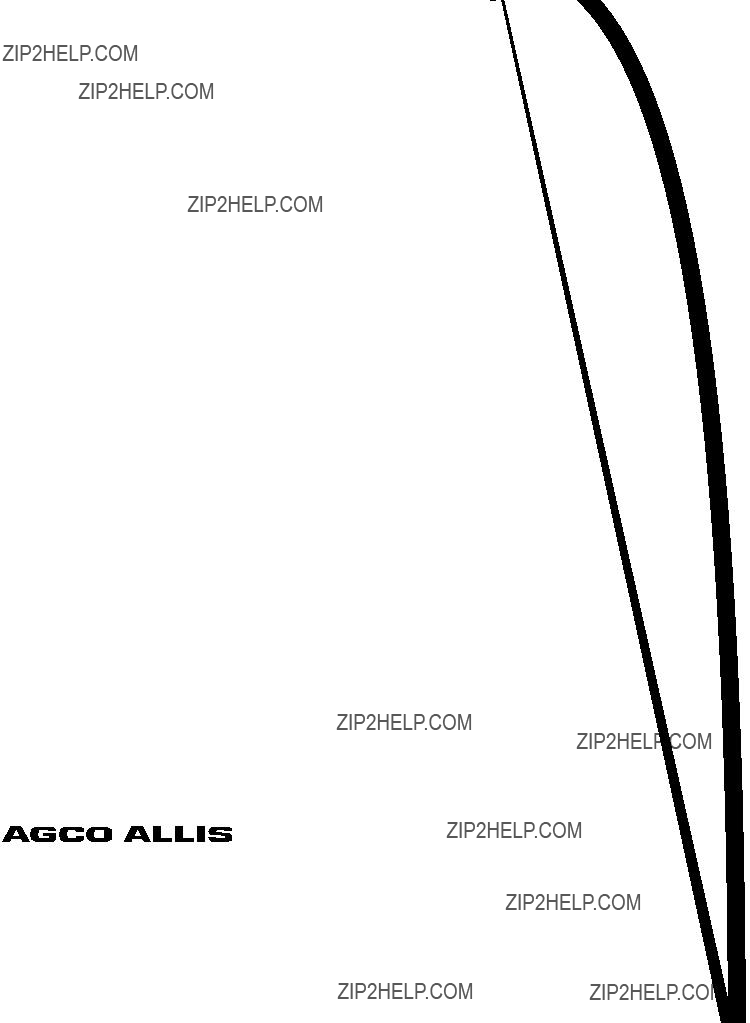
www.allislawn.com
?? Copyright 1997 Simplicity Manufacturing, Inc. All Rights Reserved. Printed in USA.

OPERATOR???S
MANUAL
2400 Series
Riders
Mfg. No. Description
1693048 2411G, 11HP Gear
1693050 2414H, 13HP Hydro
Mower Decks
Mfg. No. Description
1692544 30??? Mower Deck
1692546 34??? Mower Deck
1717741 Rev 4/97

Massey Ferguson Lawn & Garden Equipment
is Manufactured and Distributed by Simplicity Manufacturing, Inc.
500 N. Spring Street ??? P.O. Box 997 ??? Port Washington, WI
www.masseylawn.com
?? Copyright 1997 Simplicity Manufacturing, Inc. All Rights Reserved. Printed in USA.

Table Of Contents
NOTE: In this manual, ???left??? and ???right??? are referred to as seen from the operating position.
 WARNING
WARNING
Engine exhaust from this product contains chemi- cals known, in certain quantities, to cause cancer, birth defects, or other reproductive harm.
?? Copyright 1997 Simplicity Manufacturing, Inc. All Rights Reserved. Printed In USA.
TP
1
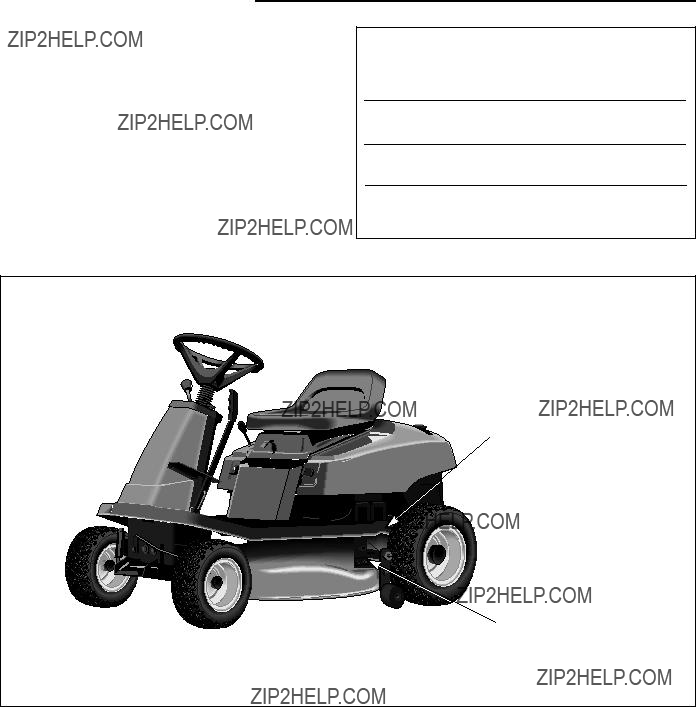
Rider & Mower Identification
IDENTIFICATION NUMBERS
Record your model number, manufacturer number and engine idnetification number in the space provided for easy reference. The models and manufacturer numbers covered in this manual are listed on the front cover. The rider I.D. tag is located on the
Refer to the engine Owner???s Manual for location of engine identification number.
Be sure to fill out and return the Warranty Registration Card supplied with your rider.
MODEL REFERENCE
Model Number:
Manufacturer Number:
Engine I.D. Number:
Dealer Name/Date Purchased:
Figure 1. Rider & Mower Identification Tags
2
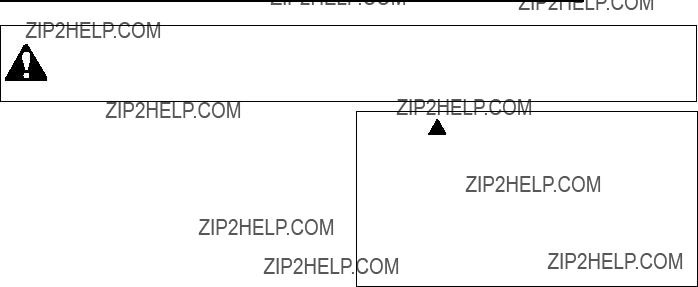
Safety Rules
Read these safety rules and follow them closely. Failure to obey these rules could result in loss of control of rider, severe personal injury or death to you, or bystanders, or damage to property or equipment. This mowing deck is capable of amputating hands and feet and throwing objects. The triangle  in text signifies important cautions or warnings which must be followed.
in text signifies important cautions or warnings which must be followed.
GENERAL OPERATION
???Read, understand, and follow all instructions in the manual and on the unit before starting.
???Only allow responsible adults, who are familiar with the instructions, to operate the unit.
???Clear the area of objects such as rocks, toys, wire, etc., which could be picked up and thrown by the blade(s).
???Be sure the area is clear of other people before mow- ing. Stop unit if anyone enters the area.
???Never carry passengers.
???Do not mow in reverse unless absolutely necessary. Always look down and behind before and while trav- elling in reverse.
???Be aware of the mower discharge direction and do not point it at anyone. Do not operate the mower without either the entire grass catcher or the deflector in place.
???Slow down before turning.
???Never leave a running unit unattended. Always disengage the PTO, set parking brake, stop engine, and remove keys before dismounting.
???Turn off the PTO switch to disengage the blades when not mowing.
 WARNING - SLOPE OPERATION Never operate on slopes greater than 30 percent (16.7??) which is a rise of three feet vertically in 10 feet horizontally. When operating on slopes that are greater than 15 percent (8.5??) but less than 30 percent use front counterweights and rear wheel weights (see your dealer). Select slow ground speed before driving onto slope. In addition to front and rear weights, use extra caution when operating on slopes with rear- mounted grass catcher. Mow UP and DOWN the slope, never across the face, use caution when changing directions and DO NOT START OR STOP ON SLOPE.
WARNING - SLOPE OPERATION Never operate on slopes greater than 30 percent (16.7??) which is a rise of three feet vertically in 10 feet horizontally. When operating on slopes that are greater than 15 percent (8.5??) but less than 30 percent use front counterweights and rear wheel weights (see your dealer). Select slow ground speed before driving onto slope. In addition to front and rear weights, use extra caution when operating on slopes with rear- mounted grass catcher. Mow UP and DOWN the slope, never across the face, use caution when changing directions and DO NOT START OR STOP ON SLOPE.
Do
???See your authorized dealer for recommendations of wheel weights or counterweights to improve stability.
???Mow up and down slopes, not across.
???Remove obstacles such as rocks, tree limbs, etc.
???Watch for holes, ruts, or bumps. Uneven terrain could overturn the unit. Tall grass can hide obstacles.
???Use slow speed. Choose a low gear so that you will not have to stop or shift while on the slope.
???Use extra care with grass catchers or other attach- ments. These can change the stability of the unit.
???Keep all movement on the slopes slow and gradual. Do not make sudden changes in speed or direction.
???Stop engine before removing grass catcher or unclogging chute.
???Mow only in daylight or good artificial light.
???Do not operate the unit while under the influence of alcohol or drugs.
???Watch for traffic when operating near or crossing roadways.
???Use extra care when loading or unloading the unit into a trailer or truck.
SLOPE OPERATION
Slopes are a major factor related to
Do Not
???Do not start or stop on a slope. If tires lose traction, disengage the blade(s) and proceed slowly straight down the slope.
???Do not turn on slopes unless necessary, and then, turn slowly and gradually downhill, if possible.
???Do not mow near
???Do not mow on wet grass. Reduced traction could cause sliding.
???Do not try to stabilize the unit by putting your foot on the ground.
???Do not use grass catcher on steep slopes.
3

Safety Rules
CHILDREN
Tragic accidents can occur if the operator is not alert to the presence of children. Children are often attracted to the unit and the mowing activity. Never assume that chil- dren will remain where you last saw them.
???Keep children out of the mowing area and under the watchful care of another responsible adult.
???Be alert and turn unit off if children enter the area.
???Before and when backing, look behind and down for small children.
???Never carry children. They may fall off and be seri- ously injured or interfere with safe unit operation.
???Never allow children to operate the unit.
???Use extra care when approaching blind corners, shrubs, trees, or other objects that may obscure vision.
TRANSPORTING AND STORAGE
???Always observe safe refueling and fuel handling prac- tices when refueling the rider after transportation or storage.
???Always follow the engine manual instructions for storage preparations before storing the rider for both short and long term periods.
???Always follow the engine manual instructions for proper
???Never store the unit or fuel container inside where there is an open flame or pilot light, such as in a water heater. Allow unit to cool before storing.
SERVICE AND MAINTENANCE
???Use extra care in handling gasoline and other fuels. They are flammable and vapors are explosive.
a)Use only an approved container.
b)Never remove gas cap or add fuel with the engine
running. Allow engine to cool before refueling. Do not smoke.
c) Never refuel the unit indoors.
???Never run a unit inside a closed area.
???Keep nuts and bolts, especially blade attachment bolts, tight and keep equipment in good condition.
???Never tamper with safety devices. Check their proper operation regularly.
???Keep unit free of grass, leaves, or other debris build- up. Clean up oil or fuel spillage.
???Stop and inspect the equipment if you strike an object. Repair, if necessary, before restarting.
???Never make adjustments or repairs with the engine running unless specified otherwise in the engine manufacturer???s manual.
???Grass catcher components are subject to wear, dam- age, and deterioration, which could expose moving parts or allow objects to be thrown. Frequently check components and replace with manufacturer???s recom- mended parts, when necessary.
???Mower blades are sharp and can cut. Wrap the blade(s) or wear gloves, and use extra caution when servicing them.
???Check brake operation frequently. Adjust and service as required.
???Use only factory authorized replacement parts when making repairs.
???Always comply with factory specifications on all settings and adjustments.
???Only authorized service locations should be utilized for major service and repair requirements.
???Never attempt to make major repairs on this unit unless you have been properly trained. Improper ser- vice procedures can result in hazardous operation, equipment damage and voiding of manufacturer???s warranty.
4

This unit has been designed and manufactured to pro- vide you with the safety and reliability you would expect from an industry leader in outdoor power equipment manufacturing.
Although reading this manual and the safety instructions it contains will provide you with the necessary basic knowledge to operate this equipment safely and effec- tively, we have placed several safety labels on the unit to remind you of this important information while you are operating your rider.
All WARNING, CAUTION and instructional messages on
Safety Decals
your rider and mower should be carefully read and obeyed. Personal bodily injury can result when these instructions are not followed. The information is for your safety and it is important! The safety decals shown below are on your rider and mower.
If any of these decals are lost or damaged, replace them at once. See your local dealer for replacements.
These labels are easily applied and will act as a constant visual reminder to you, and others who may use the equipment, to follow the safety instructions necessary for safe, effective operation.
 DANGER
DANGER
ROTATING CUTTING BLADE
Do not put hands or feet under mower deck while
blade is rotating.
1704276
Decal - Danger
Part No. 1704276
 WARNING
WARNING
AVOID SERIOUS INJURY OR DEATH
??? The operator must be in the seat.
??? To engage PTO, pull PTO switch out.
??? To disengage PTO, push PTO switch in.

 Parking Brake
Parking Brake
To Set Parking Brake
???Pull knob out while Clutch/Brake pedal is depressed.
???Release Clutch/Brake pedal while holding knob.
To Release Parking Brake
???Depress Clutch/Brake pedal.
???Push knob down while Clutch/Brake pedal is depressed.
Clutch/Brake
Pedal
 DANGER
DANGER
DO NOT TOW UNIT!
Damage may result to transmission.
Mower Height Adjust
???Pull lever back to lower mower deck.
1713490
ROTATING CUTTING BLADE
Do not operate mower without deflector or entire
grass catcher in place.
1704277
Decal - Operating Information
Part No. 1713490
Decal - Danger
Part No. 1704277
5

Features & Controls
RIDER FEATURES & CONTROLS
Figure 2. Rider Features
6

Features & Controls
ENGINE COMPARTMENT
*2387
Figure 3. Engine Compartment
7

Features & Controls
SAFETY INTERLOCK SYSTEM
Your rider is equipped with a seat switch safety system that will automatically shut the engine off when the oper- ator leaves the seat with the ground speed control lever in gear or PTO engaged. Once the engine has stopped, the electric PTO switch must be turned off after operator returns to the seat in order to start the engine.
On hydro models, the clutch/brake pedal (I, figure 2) must be fully depressed to start engine.
Check the seat switch every fall and spring with the tests listed below.
With operator in seat and ignition switch turned to ON (engine not running):
 WARNING
WARNING
If the rider does not pass the test, do not oper- ate rider . See your authorized dealer. Under no circumstance should you attempt to defeat the purpose of the safety system.
Test 1 - Engine should NOT crank if:
A.seat is not occupied or
B.transmission lever out of neutral or
C.PTO switch engaged or
D.clutch/brake pedal not fully depressed.
Test 2 - Engine should crank if:
A.seat is occupied and
B.transmission lever is in neutral and
C.PTO switch is disengaged and
D.clutch/brake pedal is fully depressed.
Test 3 - Engine should shut off if:
A.operator rises off seat with transmission lever in gear or
B.operator rises off seat with clutch/brake pedal not depressed (parking brake on) or
C.operator rises off seat with PTO engaged.
NOTE: If operator returns to seat before engine stops, the engine will
Test 4 - PTO will disengage if:
A. operator rises off seat with engine running.
NOTE: If operator returns to seat before engine stops, the engine will resume speed and electric PTO clutch will
8
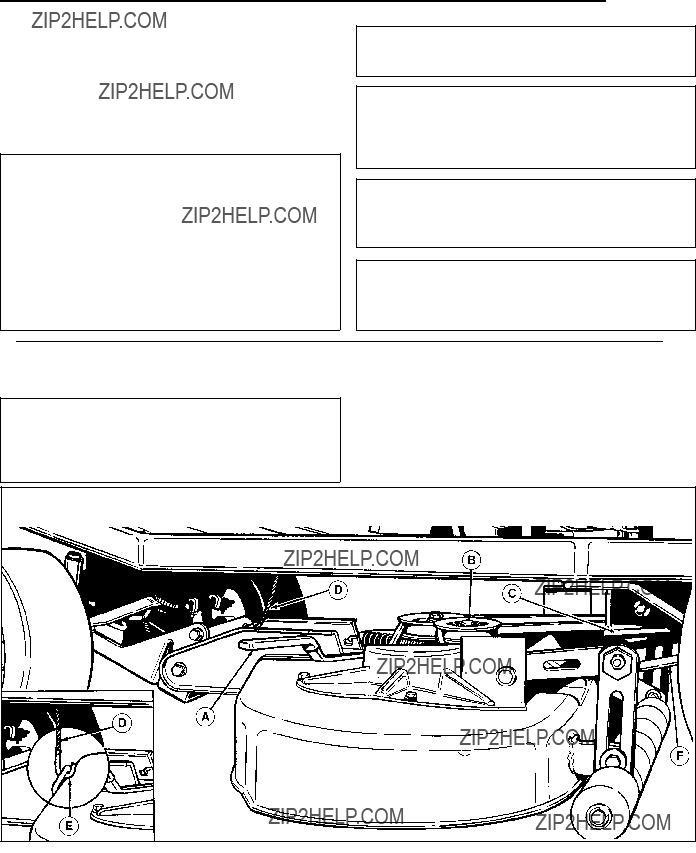
GENERAL
Before operating this rider for the first time, the owner should operate in an open area without mowing, to become accustomed to the unit. The left side of the mower can be used to trim close to objects. Be sure to read all information in the Safety and Operation sections before attempting to operate this rider and mower.
 WARNING - SLOPE OPERATION Never operate on slopes greater than 30 percent (16.7??) which is a rise of three feet vertically in 10 feet horizontally. When operating on slopes that are greater than 15 percent (8.5??) but less than 30 percent use front counterweights and rear wheel weights (see your dealer). Select slow ground speed before driving onto slope. In addition to front and rear weights, use extra caution when operating on slopes with rear- mounted grass catcher. Mow UP and DOWN the slope, never across the face, use caution when changing directions and DO NOT START OR STOP ON SLOPE.
WARNING - SLOPE OPERATION Never operate on slopes greater than 30 percent (16.7??) which is a rise of three feet vertically in 10 feet horizontally. When operating on slopes that are greater than 15 percent (8.5??) but less than 30 percent use front counterweights and rear wheel weights (see your dealer). Select slow ground speed before driving onto slope. In addition to front and rear weights, use extra caution when operating on slopes with rear- mounted grass catcher. Mow UP and DOWN the slope, never across the face, use caution when changing directions and DO NOT START OR STOP ON SLOPE.
Operation
 WARNING
WARNING
Never allow passengers to ride on the unit.
 WARNING
WARNING
Towing the rider will cause transmission dam- age. Do not use another vehicle to push or pull rider .
 WARNING
WARNING
To reduce fire hazard, keep the engine and mower free of grass, leaves and excess grease.
 WARNING
WARNING
The interlock safety switches are for your safety. Do not attempt to bypass them.
MOWER REMOVAL AND INSTALLATION
 WARNING
WARNING
Stop engine and remove key. Do not engage PTO until mower is completely removed or installed and operator is seated.
NOTE: Perform mower installation on a hard, level sur- face such as a concrete floor. For easier mower removal and installation, rear trailing arms (F, figure 5) can be removed by removing spring clips and clevis pins.
1.Park rider and turn off PTO switch and engine, remove the key and apply parking brake. Turn the wheels fully to the left.
*2396
9
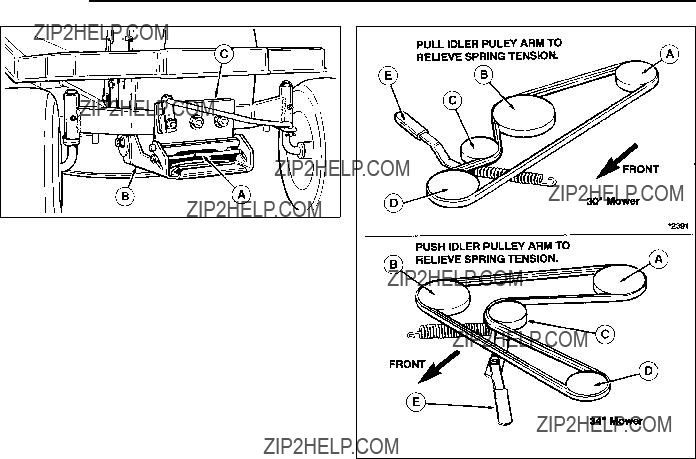
Operation
*2390
B.Mower Hitch
2.On
On
3.With belt tension relieved, remove belt from idler pul- ley (B, figure 5) and PTO pulley (C). Removing belt relieves tension on the front hitch assembly.
4.With lift lever down and
5.Remove mower hitch (B, figure 6) from rider hitch brackets (C) by pulling
6.With wheels turned fully left, remove mower from underneath
7.To install mower, reverse above steps. Check mower belt pattern as shown in figure 7. Make sure that the mower lift cable is installed with hook torward the rear and rear trailing arms (F, figure 5) are positioned above rear torsion bar.
OPERATING THE MOWER
1.When traveling to or from the work site, fully raise the mower using the mower lift lever (A, figure 11 ). At the work site, lower mower using the lift lever.
2.Use the
NOTE: Cutting height scale is located on the quadrant at base of lift lever. Scale is numbered 1 thru 4, with 4 rep- resenting the highest cutting height.
*2392
Figure 6. Mower Belt Pattern
A.PTO (Electric Clutch (Pulley)
B.Arbor Pulley (30???) Right Arbor Pulley (34???)
C.Idler Pulley
D.Front Idler Pulley (30???) Left Arbor Pulley (34???)
E.Idler Pulley Arm
CHECKS BEFORE STARTING
1.Make sure you have proper wheel or counterweights if required. See SLOPE OPERATION in the Safety Rules section. Make sure any slopes are within required limits.
2.Check that crankcase is filled to full mark on dipstick. See the engine Operator???s Manual for instructions and oil recommendations.
3.Make sure all nuts, bolts, screws and pins are in place and tight.
4.Make sure you can reach all controls from operator???s positions. If not, see SEAT ADJUSTMENT.
5.Fill the gasoline tank with fresh gasoline. Fill to bot- tom of filler neck to avoid spillage and overflow. DO NOT mix oil with gasoline. Refer to engine manual for gasoline recommendations.
10
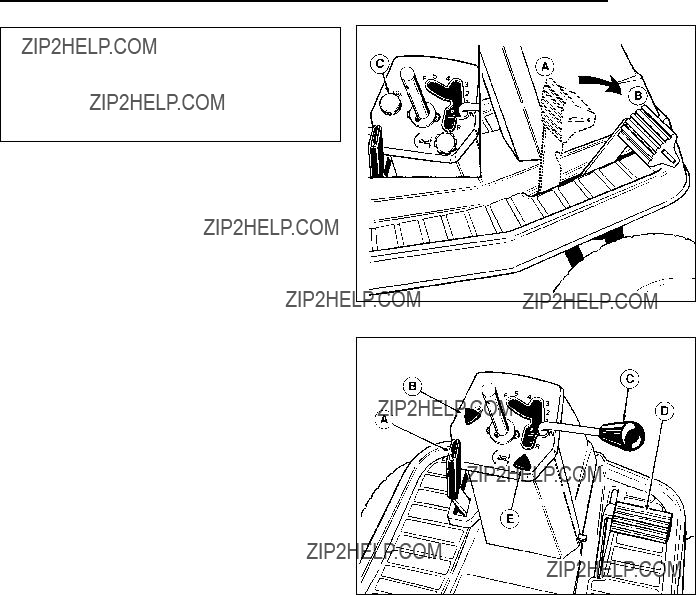
 WARNING
WARNING
Gasoline is highly flammable and must be han- dled with care. Never fill the tank when the engine is still hot from recent operation. Do not allow open flame, smoking or matches in the area. Avoid
CLUTCH/BRAKE PEDAL
OPERATION - HYDRO MODELS
1.See figure 10. Depressing the pedal from position A to B disengages the transmission drive and also returns the transmission control lever to neutral (from forward speeds). Fully depressing the pedal to position B applies the rider brake.
2.Parking brake is applied at pedal position B when parking brake control knob (C, figure 10) is pulled up with pedal fully depressed.
CLUTCH/BRAKE PEDAL
OPERATION - GEAR MODELS
1.See figure 10. Depressing the clutch pedal from posi- tion A to B activates neutral start circuit, disengages the transmission drive belt and allows the gear lever to be shifted.
2.Fully depressing the clutch/brake pedal from position A to B applies the rider brake. Parking brake is applied at position B when parking brake control knob (C, figure 10) is pulled up with pedal depressed.
STARTING THE ENGINE
1.Seat yourself on the rider seat in the operating posi- tion. Set the parking brake using the clutch/brake pedal (D, figure 11) and parking brake knob (B).
2.Push down on the switch (G, figure 2) to disengage the PTO and place the ground speed control lever (C, figure 11) in neutral.
3.For cold starts, set the engine speed control (M, fig- ure 2) to the choke position. For warm starts, set engine speed control lever at 1/2 throttle position .
4.Turn the key (C, figure 2) to start and release when engine has started.
5.Move the engine speed control lever (M, figure 2) to the slow position. Warm up the engine by running it for at least a minute before engaging the PTO or dri- ving the rider .
SELECTING GROUND
& ENGINE SPEED
On hydro models, ground speed is infinitely variable
Operation
Figure 10. Clutch/Brake Pedal
*2394
Figure 11. Controls
A.Mower Lift Lever
B.Parking Brake Knob
C.Ground Speed Control Lever
D.Clutch/Brake Pedal
E.
according to how far the control lever (C, figure 11) is moved in the forward or reverse position.
On gear models, ground speed is selected by depress- ing the clutch/brake pedal (D, figure 11) and moving the control lever (C, figure 11) to the appropriate gear selec- tion. Most mowing is done in 3rd or 4th gear with engine set at full speed. If the terrain is rough, hilly or sloping, use first or second gear. If the grass is wet or over 3??? (76mm) high, use full engine speed (with low gear) so the mower will have enough power to cut the grass.
11
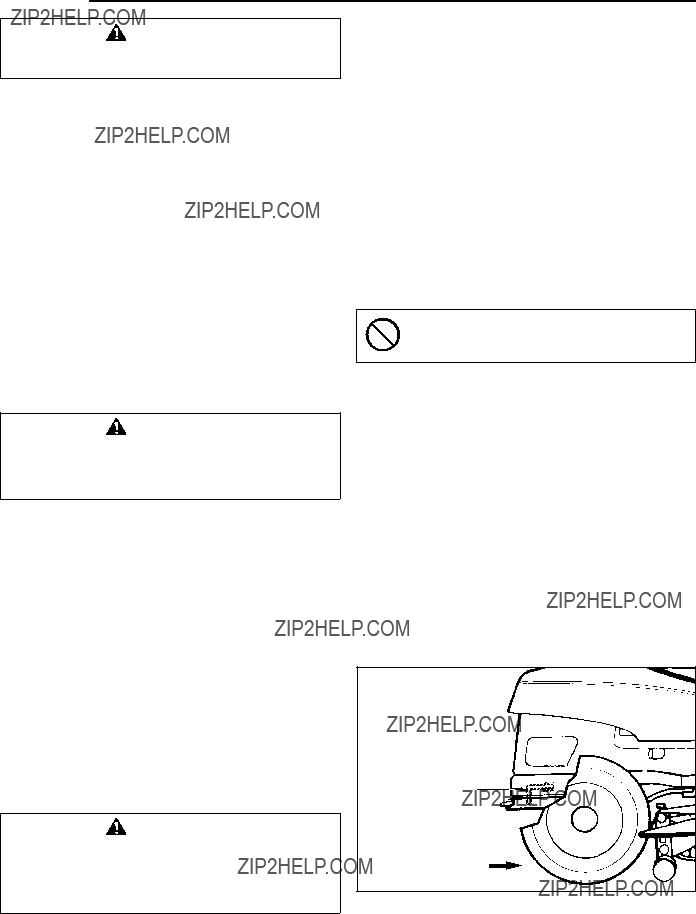
Operation
WARNING
Make sure desired direction of travel is clear of objects, people and animals.
1.If you are ready to mow, lower the mower from the transport position using lever (A, figure 11) and set the mowing height using the
2.Set the engine speed control lever (M, figure 2) for full speed.
3.Use the PTO switch (G, figure 2) to engage the PTO.
4.Release the parking brake by depressing the clutch/brake pedal (D, figure 11) and pushing knob
(B) down.
5.On hydro models, move the ground speed control lever (C, figure 11) to the desired direction and speed of travel to set the rider in motion.
On gear models, depress clutch/brake pedal, use the ground speed control lever to select the proper gear for conditions, then slowly release clutch/brake pedal to set the rider in motion.
6.Adjust engine speed control lever (M, figure 2) to the desired speed. Between 3/4 and full speed is recom- mended for mowing.
WARNING
Before leaving the operator???s position for any reason, engage the parking brake, disengage the PTO, stop the engine and remove the key.
STOPPING THE RIDER
1.On hydro models, move the ground speed control lever (C, figure 11) into the NEUTRAL position to make a gradual stop. To make a more rapid stop, depress the clutch/brake pedal (D, figure 11).
NOTE: On hydro models, the ground speed control lever will return to neutral from forward automatically when the clutch/brake pedal is depressed.
On gear models, press the clutch/brake pedal (D, figure 11) down only far enough to disengage the clutch to make a gradual stop. For a more rapid stop, press pedal down farther to apply the brake. Move the ground speed control lever to NEUTRAL before releasing the pedal.
2.Engage the parking brake by fully depressing clutch/brake pedal and pulling up on parking brake knob (B, figure 11).
WARNING
To reduce fire hazard, keep the engine, rider and mower free of grass, leaves and excess grease. Do not stop or park rider over dry leaves, grass or combustible materials.
3.Use the PTO switch (G, figure 2) to disengage the PTO.
4.Set the engine speed control lever (M, figure 2) to 1/2 throttle setting and allow the engine to idle for 20 sec- onds. Stopping a hot engine too fast may cause engine damage.
5.Turn key (C, figure 2) to OFF and remove it.
NEUTRAL SAFETY CHECKS
NEUTRAL GATE CHECK: The unit should not move when the ground speed control lever is in the neutral gate.
If the unit fails either of these checks, the unit should be properly readjusted by an authorized servicing dealer before use.
Do not tow the rider.
Damage will result to the transmission/axle.
PUSHING THE RIDER BY HAND
Hydro Models
1.Engine should be off and ignition key removed.
2.Place the mower in the transport position (up) using the mower lift lever (A, figure 11).
3.See figure 12. To push the rider by hand, the release lever must be placed in the PUSH position.
4.To drive the rider, release lever must be moved to the DRIVE position.
Gear Model
1.Engine should be off and ignition key removed.
2.Place the mower in the transport position (up) using the mower lift lever (A, figure 11).
3.Depress the clutch/brake pedal and place the ground speed control lever (C, figure 11) in the neutral gate.
4.Unlock the parking brake.
*2511
Move forward for drive position, pull rearward for push position.
Forward
Figure 12. Transaxle Release Lever - Hydro Models
12

GENERAL
For the first use of the mower, choose a smooth level area. Cut long straight strips overlapping slightly.
The size and type of area to be mowed determines the best mowing pattern to use. Obstructions such as trees, fences and buildings must also be considered. Where possible, make one or two passes in a counterclockwise direction around the outside of the area to keep the cut grass off fences and walks. The remainder of the mow- ing should be done in a clockwise direction so the clip- pings are dispersed on the cut area.
Keep in mind the following lawn care and mowing tips:
???Too much maintenance is as detrimental to your lawn as neglect.
???Mow when grass is
???For extremely tall grass, set the cutting height at maximum for the first pass, and then reset to the desired height and mow again.
???Mow often. Short clippings of an inch or less decom- pose more quickly than longer blades.
???Keep the blades on your mower sharp for finer clip- pings.
???Let grass grow a bit longer when it is hot to reduce heat
???Use
???Don???t cover grass surface with a heavy layer of clip- pings. Consider using a grass collection system and starting a compost pile.
???Aerate lawn in spring, consider renting an aerator which removes cores of soil from the lawn. This increases the speed of clipping decomposition and deep root growth by opening up the soil and permitting greater movement of water, fertilizer and air.
???Don???t
???Mow when the grass is dry, preferably in the late afternoon when the temperatures are cooler.
???Where possible, change patterns occasionally to eliminate matting, graining or a corrugated appear- ance.
???For wet grasses, grasses prone to wheel tracking and for collecting clippings:
a.Use sharp blades.
b.Raise deck 1/4??? higher in front than in rear.
c.Run at maximum engine speed but slow ground speed.
d.Clean deck of
e.Check for free movement of mower idler pulley.
Mowing Patterns & Tips
???For dry conditions where grass
a.Use sharp blades.
b.Raise deck so the front is even with, or 1/8??? lower than, rear.
c.Use 3/4 engine speed.
d.Clean deck of
MULCHING MOWER OPERATION
(OPTIONAL KIT ATTACHMENT)
Mulching
Mulching consists of actually cutting and recutting clip- pings into tiny particles and blowing them into the lawn. These tiny particles decompose rapidly into
Keep in mind these mulching tips:
???Use mulching mower or mulcher kit without shred- ders for grass mulching.
???Install shredders for leaf shredding.
???Use maximum engine speed.
???Raise height of cut if excessive power is used.
???Must use sharp blades. Do not use lift tabs or high lift blade when mulching.
???Adjust to lower ground speeds in heavy grass or if windrow is present.
???Clean deck of
???Check for free movement of mower idler pulley.
Mowing Conditions
The best mulching results from mowing when lawn is dry and grass blades are not over 5??? long. Follow these guidelines for best results:
???Do not use the mower as a mulching mower during the first two or three mowings in the spring. The long grass blades, quick growth, and often wetter condi- tions are more suitable for
???Avoid mulching after rain or heavy dew. It may be better to mow later in the day or early evening when lawn is drier.
???Change the mowing pattern each time.
13
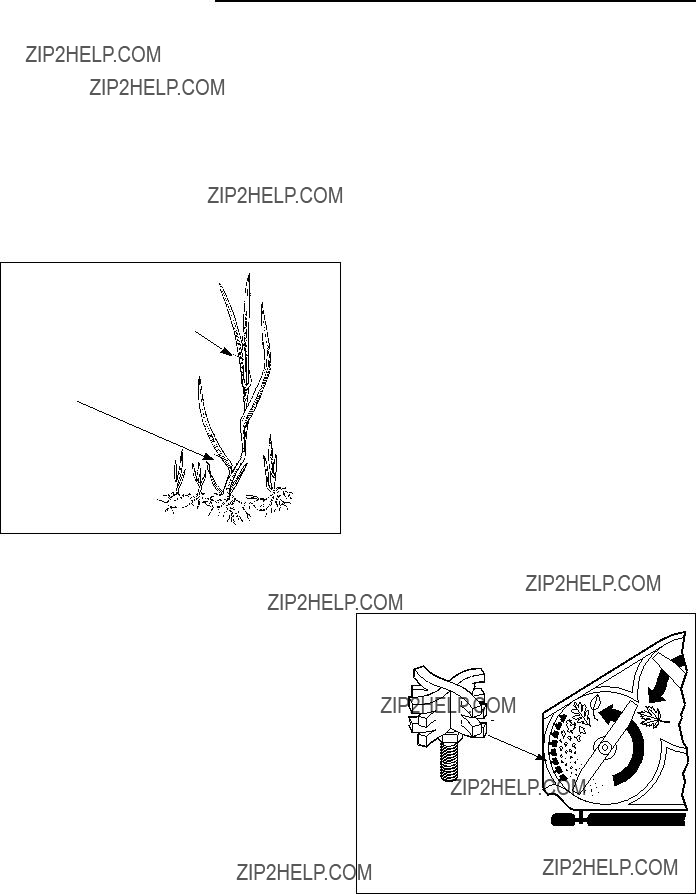
Mowing Patterns & Tips
???If mulching baffles are removed, the original deflector must be in operating position for safe
How Much Grass To Cut Off
Removing too much grass height in one cutting may result in an unsatisfactory cut: windrowing, clumping, or uneven dispersal of clippings may result. It is best to mow when the grass is between 3???- 5??? tall, although this will depend on your personal preference for lawn appear- ance. A good rule to follow is to cut only the top one- third of the grass blade at a time (maximum of
Optimal cutting point
This area can contribute to thatch
Engine Speed & Ground Speed
Use full engine throttle matched with a slower ground speed so that clippings will be finely cut. A better cut may result from cutting the same area in two passes, each time cutting only 3/4??? of grass blade. Short clip- pings of 1??? or less decompose more quickly than longer blades.
NOTE: When mulching under heavy cutting conditions, a rumbling sound may be present and is normal.
The Proper Equipment
Always keep the mower blades sharp and balanced. Blades should be sharpened at the beginning of every mowing season. If the tips of grass blades brown after cutting, this may be a sign of dull blades tearing, rather than cutting, the grass blades.
Keep the underside of the mower deck and baffles clean so that clippings are properly circulated, chopped, and discharged back into the lawn.
The Best Combination
We recommend that you experiment with the height of cut position and rider ground speed that will give you the best cut. Start with a higher cutting height and try increasing lower settings until you find a cutting height that is matched to your mowing conditions and prefer- ences. Since mulching requires more horsepower than
Clippings Are Beneficial
A common misconception about clippings is that they automatically lead to thatch. However, clippings pro- duced by mulching methods actually contribute to a healthy lawn because they:
???Act as a safe,
And one garbage bag of clippings contains about 1/4 lb. of usable organic nitrogen.
???Reduce the evaporation of water from your lawn.
???Provide a cushioning layer to reduce lawn wear.
???Moderate soil temperature.
???Save money normally spent on trash bags.
Leaf Shredding - 34??? Mower Deck Only (For use with Mulcher Kit Only)
Patented Shredder Blades virtually eliminate raking leaves. Up to 512 cutting edges pulverize leaves into tiny particles, which quickly and naturally decompose into food for your lawn. Shredder Blades must be removed when you choose to mulch grass clippings.
14

Normal Care
SCHEDULE
The following schedule should be followed for normal care of your rider and mower. You will need to keep a record of your operating time. Determining operating time is easily accomplished by multiplying the time it takes to do one job by the number of times you???ve done the job, or you can install the optional hour meter.
*See the engine manufacturer's owner's manual.
**Change original engine oil after first 5 hours of operation.
***More often in hot (over 85?? F: 30?? C) weather or dusty operating conditions.
****Transaxle is a sealed unit and requires no regular interval fluid changes.
RAISING THE SEAT DECK
To gain access to the engine compartment, simply raise the seat deck forward.
CHECKING TIRE PRESSURE
Front and rear tire pressure should be 10 to12 psi (68 to 82 kPa)
CHECKING/ADDING GASOLINE
Check the gas gauge/cap to be sure there is enough gasoline to complete the job. To add gasoline, remove the gas gauge/cap. Do not overfill. Leave room in the tank for fuel expansion. Refer to your engine manual for gasoline recommendations. Install and hand tighten the gas gauge/cap.
CAUTION
Never use gasoline containing METHANOL, gaso- hol containing more than 10% ethanol, gasoline additives, premium gasoline, or white gas because engine/fuel system damage could result.
CHECKING FUEL FILTER
WARNING
Do not remove fuel filter when engine is hot, as spilled gasoline may ignite. DO NOT spread hose clamps further than necessary. Ensure clamps grip hoses firmly over filter after installation.
The fuel filter is located in fuel line between fuel tank and carburetor. If filter is dirty or clogged, replace as follows. Place a container below filter to catch spilled gasoline.
1.Using a pliers, open and slide hose clamps from fuel filter.
2.Remove hoses from filter.
3.Install new filter in proper flow direction in fuel line. Secure with hose clamps. See warning at beginning of procedure.
15
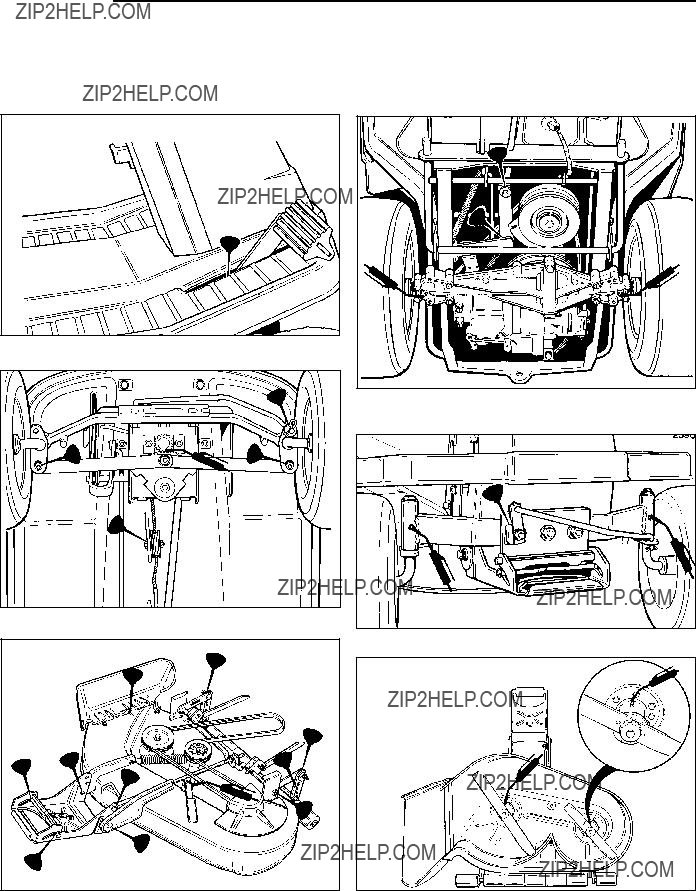
Normal Care
LUBRICATION
Lubricate the rider and mower as shown in figures 13 - 18. When a grease gun is shown, wipe the fitting clean, apply two or three shots of lithium base automotive
*2388B
Figure 13. Brake Pedal Pivot Point
Figure 14. Rider Lubrication Points - Front Half
*2397
Figure 15. Front Axle Lubrication Points
grease, and wipe off excess grease. When an oil can is shown, wipe the area clean, apply a few drops of oil (SAE 30), then wipe up drips or spills.
*2402
Figure 16. Rider Lubrication Points - Rear Half (Gear
Model Shown)
*2390
Figure 17. Front Axle Lubrication Points
Note: On 30??? mower, grease fitting is on topside of deck.
Figure 18. Arbor Lubrication Points
16
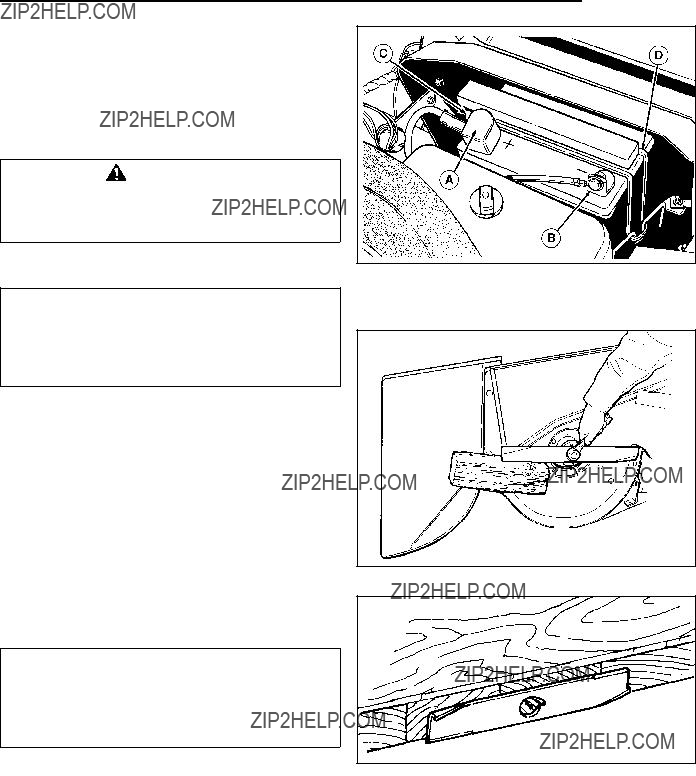
BATTERY MAINTENANCE
Checking the Battery Fluid
1.Raise the seat deck.
2.Remove battery filler cap. Fluid must be even with split ring full mark. If not, add distilled water.
3.Reinstall filler cap.
WARNING
Be careful when handling the battery. Avoid spilling electrolyte. Keep flames and sparks away from the battery.
Cleaning the Battery and Cables
 WARNING
WARNING
When removing or installing battery cables, dis- connect the negative cable FIRST and reconnect it LAST. If not done in this order, the positive ter- minal can be shorted to the frame by a tool.
1.Disconnect the cables from the battery, negative cable first (B, figure 19).
2.Remove the battery clamp, then remove the battery.
3.Scrub the battery, cables and battery compartment with baking soda and water.
4.Clean the battery terminals and cable clamps with a wire brush and battery post terminal cleaner.
5.Reinstall battery and clamp.
6.Connect cables, positive cable first.
7.Coat cable clamps and terminals with grease or petroleum jelly.
SERVICING THE MOWER BLADES
 WARNING
WARNING
For your personal safety, do not handle the sharp mower blades with bare hands. Careless or improper handling of blades may result in serious injury.
1.Remove mower from the rider.
2.Blades should be sharp and free of nicks and dents. If not, sharpen blades as described in following steps.
Normal Care
Figure 19. Battery
A. Positive Battery Terminal C. Vent Tube
B. Negative Battery Terminal D. Holddown Strap
Figure 20. Removing The Blade
*169
Figure 21 Balancing The Blade
17
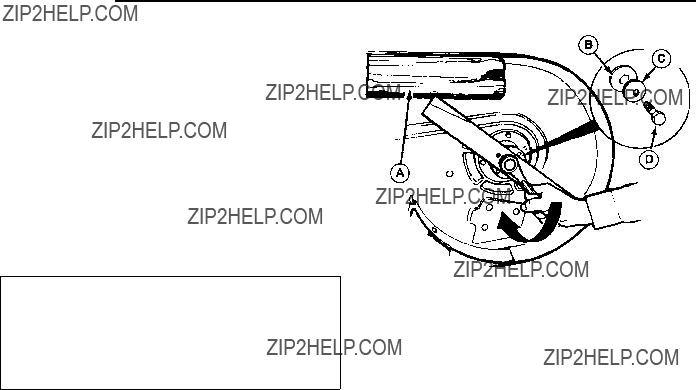
Normal Care
3.To remove blade for sharpening, use wooden block to hold blade while removing the blade mounting cap- screw (figure 20).
4.Use a file to sharpen blade to fine edge. Remove all nicks and dents in blade edge. If blade is severely damaged, it should be replaced.
5.Balance the blade as shown in figure 21. Center the blade???s hole on a nail lubricated with a drop of oil. A balanced blade will remain level.
6.Reinstall each blade with the tabs pointing up toward deck as shown in figure 22. Secure with a capscrew (D), cup washer (C) and spline washer (B). Use a wooden block to prevent blade rotation and torque capscrews to
 WARNING
WARNING
For your personal safety, blade mounting cap- screws must each be installed with a cup washer and spline washer, then securely tightened. Torque blade mounting capscrew to
18

Storage
 WARNING
WARNING
Never store the rider, with gasoline in engine or fuel tank, in a heated shelter or in enclosed, poorly venti- lated enclosures. Gasoline fumes may reach an open flame, spark or pilot light (such as a furnace, water heater, clothes dryer, etc.) and cause an explosion.
Handle gasoline carefully. It is highly flammable and careless use could result in serious fire damage to your person or property.
Drain fuel into an approved container outdoors away from open flame or sparks.
TEMPORARY STORAGE
(30 Days Or Less)
Remember, the fuel tank will still contain some gasoline, so never store the rider indoors or in any other area where fuel vapor could travel to any ignition source. Fuel vapor is also toxic if inhaled, so never store the rider in any structure used for human or animal habitation.
Here is a checklist of things to do when storing your rider temporarily or in between uses:
???Keep the rider in an area away from where children may come into contact with it. If there???s any chance of unauthorized use, remove the spark plug (s) and put in a safe place. Be sure the spark plug opening is protected from foreign objects with a suitable cover.
???If the rider can???t be stored on a reasonable level sur- face, chock the wheels.
???Clean all grass and dirt from the mower.
NOTE: If storing your rider between winter snow removal jobs in a cold area, we suggest that you fill the fuel tank at the completion of each job to prevent water condensa- tion in the fuel tank. Wait for engine to cool before filling tank.
LONG TERM STORAGE
(Longer Than 30 Days)
Before you store your rider for the
1.Drain crankcase oil while engine is hot and refill with a grade of oil that will be required when rider is used again.
2.Prepare the mower deck for storage as follows: a. Remove mower deck from the rider.
b.Clean underside of mower deck.
c.Coat all bare metal surfaces with paint or light coat of oil to prevent rusting.
3.Clean external surfaces and engine.
4.Prepare engine for storage. See engine owner???s manual.
5.Clean any dirt or grass from cylinder head cooling fins,engine housing and air cleaner element.
6.Cover air cleaner and exhaust outlet tightly with plas- tic or other waterproof material to keep out moisture, dirt and insects.
7.Completely grease and oil rider as outlined in the Normal Care section.
8.Clean up rider and apply paint or rust preventative to any areas where paint is chipped or damaged.
9.Be sure the battery is filled to the proper level with water and is fully charged. Battery life will be increased if it is removed, put in a cool, dry place and fully charged about once a month. If battery is left in rider, disconnect the negative cable.
10.Drain fuel system completely or add a gasoline stabi- lizer to the fuel system. If you have chosen to use a fuel stabilizer and have not drained the fuel system, follow all safety instructions and storage precautions in this manual to prevent the possibility of fire from the ignition of gasoline fumes. Remember, gasoline fumes can travel to distant sources of ignition and ignite, causing risk of explosion and fire.
NOTE: Gasoline, if permitted to stand unused for extend- ed periods (30 days or more), may develop gummy deposits which can adversely affect the engine carbure- tor and cause engine malfunction. To avoid this condi- tion, add a gasoline stabilizer to the fuel tank or drain all fuel from the system before placing unit in storage.
19

Storage
11.Transport the rider to a suitable, dry, indoor location. If the rider is to be stored 6 months or longer, block the rider up off the wheels to relieve weight and also to keep the tires off a damp floor. Protect tires from prolonged exposure to direct sunlight.
STARTING AFTER
LONG TERM STORAGE
Before starting the rider after it has been stored for a long period of time, perform the following steps.
1. Remove the blocks from under the rider.
2.Install the battery if it was removed.
3.Unplug the exhaust outlet and air cleaner.
4.Fill the fuel tank with fresh gasoline. See engine manual for recommendations.
5.Check crankcase oil level and add proper oil if necessary.
6.Inflate tires to proper pressure. Check fluid levels.
7.Start the engine and let it run slowly. DO NOT run at high speed immediately after starting. Be sure to run engine only outdoors or in well ventilated area.
20

GENERAL
 WARNING
WARNING
To avoid serious injury, perform maintenance on the rider or mower only when the engine is stopped and the parking brake engaged. Always remove the ignition key, disconnect spark plug wire and fasten away from the plug before begin- ning the maintenance, to prevent accidental starting of the engine.
This section of the manual provides troubleshooting and repair instructions for the more common and easily cor- rected problems. For other problems, it is recommended that you contact your dealer. Locate the problem that best describes the trouble that you have encountered. Check the possible causes one at a time, in the order that they are listed.
TROUBLESHOOTING THE RIDER
Engine will not turnover or start.
1.Ground speed control lever not in
2.PTO (electric clutch) switch in ON position. Place in OFF position.
3.Out of fuel. If engine is hot, allow it to cool, then refill the fuel tank.
4.Engine flooded.. Move throttle control out of CHOKE position .
5.Circuit breaker tripped. Wait one minute for automatic reset. Replace if defective (see your dealer).
6.Battery terminals require cleaning. See Normal Care section.
7.Battery discharged or dead. Recharge or replace.
8.Wiring loose or broken. Visually check wiring & replace broken or frayed wires. Tighten loose connections.
9.Solenoid or starter motor faulty. Repair or replace.
10.Safety interlock switch or module faulty. Replace if needed (see your dealer.)
11.Spark plug(s) faulty, fouled or incorrectly gapped. Clean and gap or replace. See engine manual.
12.Water in fuel. Drain fuel & refill with fresh fuel.
13.Old stale gas. Drain fuel & replace with fresh fuel.
14.Clutch/brake pedal not depressed.
Engine starts hard or runs poorly.
1.Fuel mixture too rich. Move the throttle control out of the CHOKE position. If problem persists, clean the air filter. See engine manual.
Troubleshooting & Repair
2.Carburetor adjusted incorrectly. See engine manual.
3.Spark plug(s) faulty, fouled, or incorrectly gapped. Clean and gap or replace. See engine manual.
Engine knocks.
1.Low oil level. Check/add oil as required.
2.Using wrong grade oil. See engine manual.
Excessive oil consumption.
1.Engine running too hot. Clean engine fins, blower screen and air cleaner.
2.Using wrong weight oil. See engine manual.
3.Too much oil in crankcase. Drain excessive oil.
Engine exhaust is black.
1.Dirty air filter. Clean air filter. See engine manual.
2.Chok enot fully opern. Move throttle control out of CHOKE position. If problem persists, check air filter and carborator adjustemtns. See engine manual.
Engine runs, but rider will not drive.
1.Ground speed control lever in neutral. Shift in forward or reverse.
2.(Hydro models only) Transmission release lever in ???push??? position. Move into drive position.
3.Belt is broken. See Drive Belt Replacement.
4.Drive belt slips. See problem and cause below.
5.Brake is not fully released. See Brake Adjustment.
Rider drive belt slips.
1.Clutch is out of adjustment. See your dealer.
2.Pulleys or belt greasy or oily. Clean as required.
3.Belt stretched or worn. Replace with correct belt.
4.Idler pulley pivot bracket ???frozen??? in declutched posi- tion. Remove idler pulley, clean and lubricate.
Brake will not hold.
1.Brake is incorrectly adjusted. See Brake Adjustment.
2.Internal brake disc on transaxle worn. See your dealer.
Rider steers hard or handles poorly.
1.Steering linkage is loose. Check and tighten any loose connections. See Steering Gear Adjustment.
2.Improper tire inflation. Check and correct.
3.Spindle bearings dry. Grease spindles. See Lubricating the rider.
21
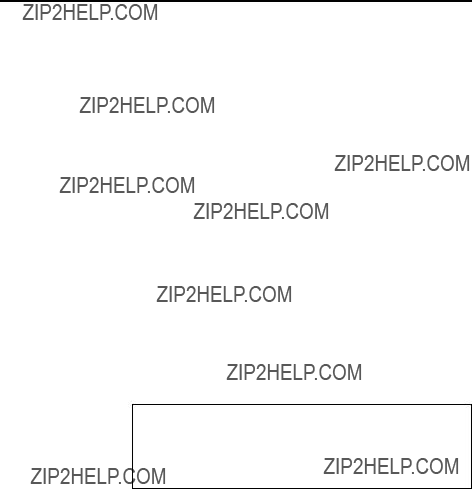
Troubleshooting & Repair
TROUBLESHOOTING THE MOWER
Mower will not raise.
1.Lift cable not properly attached or damaged. Attach or repair.
Mower drive belt slips or fails to drive.
1.Idler pulley spring broken or not properly attached. See your dealer.
2.Mower drive belt broken. Replace.
Mower cut is uneven.
1.Mower not leveled properly. See Mower Adjustment.
2.Rider tires not inflated equally or properly. See Normal Care.
Mower cut is rough looking.
1.Engine speed too slow. Set to full speed.
2.Ground speed too fast. Set ground speed control lever at a slower ground speed.
3.Blades dull and require sharpening. See Servicing the Mower Blades.
4.Mower drive belt slipping. Belt oily or worn. Clean or replace belt as necessary.
5.Check PTO (Electric Clutch) Adjustment. Clutch may need to be adjusted.
6.Blades not properly fastened to arbors. See Servicing the Mower Blades.
Engine stalls easily with mower engaged.
1.Engine speed too slow. Set for 3/4 to full throttle.
2.Ground speed too fast.
3.Carburetor not adjusted properly.
4.Cutting height set too low when mowing tall grass. Cut tall grass at maximum cutting height during first pass.
5.Discharge chute jamming with cut grass. Cut grass with discharge pointing toward previously cut area.
Excessive mower vibration.
1.Blade mounting screws are loose. Tighten to
2.Mower blade(s), arbors, or pulleys are bent. Check and replace as necessary.
3.Mower blade(s) out of balance. Remove, sharpen and balance blade(s). See Servicing the Mower Blade(s).
4.Belt installed incorrectly. See Belt Replacement.
Excessive belt breakage.
1.Bent or rough pulleys. Repair or replace.
2.Using incorrect belt. See your dealer.
CHECKING THE BATTERY
The voltmeter can be used to determine condition of bat- tery. When engine is off, the voltmeter shows battery voltage, which should be 12 volts. When engine is run- ning, the voltmeter shows voltage of charging circuit which normally is 13 to 14 volts.
A dead battery or one too weak to start the engine may not mean the battery needs to be replaced. It may, as an example, mean that the alternator is not charging the battery properly. If there is any doubt about the cause of the problem, see your dealer. If you need to replace the battery, follow the steps under Cleaning the Battery & Cables in the Normal Care Section.
CHARGING THE BATTERY
 WARNING
WARNING
Do not attempt to charge a frozen battery. Allow the battery to warm to 60?? F (15.5?? C) before plac- ing on charge.
1.Be aware of all the safety precautions you should observe during the charging operation. If you are unfamiliar with the use of a battery charger and hydrometer, have the battery serviced by your dealer.
2.Add distilled water sufficient to cover the plates (fill to the proper level near the end of the charge). If the battery is extremely cold, allow it to warm before adding water because the water level will rise as it warms. Also, an extremely cold battery will not accept a normal charge until it becomes warm.
3.Always unplug or turn the charger off before attach- ing or removing the clamp connections.
4.Carefully attach the clamps to the battery in proper polarity (usually red to [+] positive and black to
5.While charging, periodically measure the temperature of the electrolyte. If the temperature exceeds 125?? F (51.6?? C), or if violent gassing or spewing of elec- trolyte occurs, the charging rate must be reduced or temporarily halted to prevent battery damage.
22
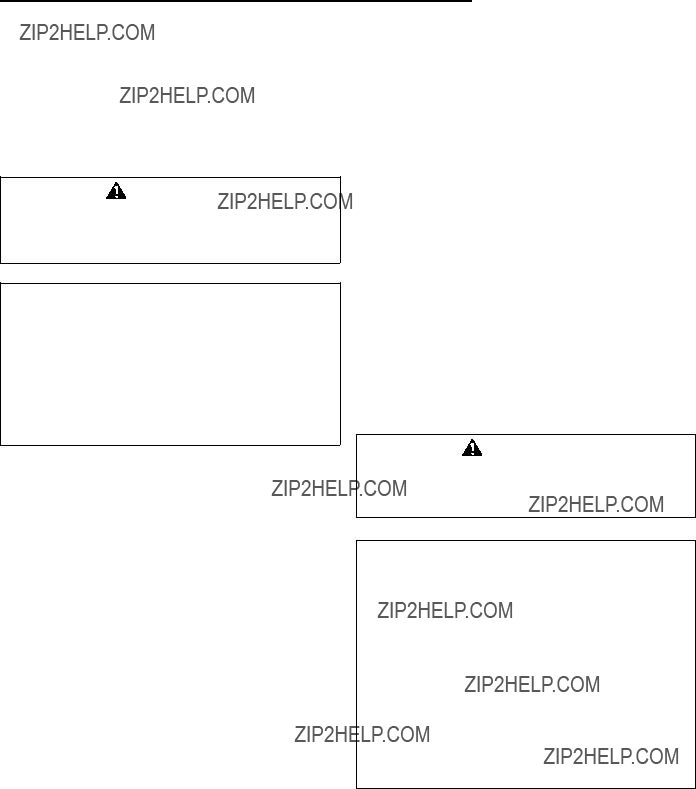
6.Charge the battery until fully charged (i.e. until the specific gravity of the electrolyte is 1.250 or higher and the electrolyte temperature is at least 60?? F). The best method of making certain a battery is fully charged, but not over charged, is to measure the specific gravity of a cell once per hour. The battery is fully charged when the cells are gassing freely at low charging rate and less than 0.003 change in specific gravity occurs over a three hour period.
WARNING
Keep open flames and sparks away from the bat- tery; the gasses coming from it are highly explo- sive. Ventilate the battery well during charging.
 WARNING
WARNING
For your personal safety, use extreme care when jump starting. Never expose battery to open flame or electric spark ??? battery action generates hydrogen gas which is flammable and explosive.
Do not allow battery acid to contact skin, eyes, fabrics, or painted surfaces. Batteries contain a sulfuric acid solution which can cause serious personal injury or property damage.
JUMP STARTING WITH AUXILIARY
(BOOSTER) BATTERY
The recomended preocedure for starting a tractor with a dead battery is to remove the battery and charge it with a battery charger as describes in the Charging the Battery section. Jump starting is not recommended. However, if it must be done, follow these directions. Both booster and
1.Both batteries must be of the same voltage (6, 12, etc.).
2.Position the vehicle with the booster battery adjacent to the vehicle with the discharged battery so that booster cables can be connected easily to the batter- ies in both vehicles. Make certain vehicles do not touch each other.
3.Wear safety glasses and shield eyes and face from batteries at all times. Be sure vent caps are tight. Place damp cloth over vent caps on both batteries.
4.Connect positive (+) cable to positive post of dis- charged battery (wired to starter or solenoid).
5.Connect the other end of same cable to same post marked positive (+) on booster battery.
Troubleshooting & Repair
6.Connect the second cable negative
7.Make final connection on engine block of stalled vehi- cle away from battery. Do not lean over batteries.
8.Start the engine of the vehicle with the booster bat- tery. Wait a few minutes, then attempt to start the engine of the vehicle with the discharged battery.
9.If the vehicle does not start after cranking for thirty seconds, STOP PROCEDURE. More than thirty sec- onds seldom starts the engine unless some mechani- cal adjustment is made.
10.After starting, allow the engine to return to idle speed. Remove the cable connection at the engine or frame. Then remove the other end of the same cable from the booster battery.
11.Remove the other cable by disconnecting at the dis- charged battery first and then disconnect the oppo- site end from the booster battery.
12.Discard the damp cloths that were placed over the battery vent caps.
WARNING
To avoid engine damage, do not disconnect bat- tery while engine is running. Be sure terminal connections are tight before starting.
 WARNING
WARNING
Any procedure other than the preceding could result in: (1) personal injury caused by elec- trolyte squirting out the battery vents, (2) per- sonal injury or property damage due to battery explosion, (3) damage to the charging system of the booster vehicle or of the immobilized vehicle.
Do not attempt to jump start a vehicle having a frozen battery because the battery may rupture or explode. If a frozen battery is suspected, examine all fill vents on the battery. If ice can be seen or if the electrolyte fluid cannot be seen, do not attempt to start with jumper cables as long as the battery remains frozen.
23

Troubleshooting & Repair
**1582
MAKE CERTAIN VEHICLES DO NOT TOUCH
Figure 23. Battery Jump Starting Diagram
24

 WARNING
WARNING
To avoid serious injury, perform adjustments only with engine stopped, key removed and rider on level ground.
SEAT ADJUSTMENT
Use the lever to adjust the seat forward or rearward for best rider comfort.
BRAKE ADJUSTMENT
Brake Adjustment - Gear Models
1.Place the transmission in gear and release the park- ing brake.
2.Move the brake lever (B) forward. There should be a 1/8" gap between the lever (B) and the stop (C) as shown in figure 24.
3.To adjust clearance, turn nut (D) clockwise to decrease the gap or turn nut counterclockwise to increase the gap.
4.Set the parking brake. Loosen or tighten adjustment nut (E) to achieve a 2
Brake Adjustment - Hydro Models
1.Release the parking brake.
2.Place a .025" feeler gauge (A, figure 25) between the two outer brake stators (refer to inset illustration). The gap should be
a.Remove cotter pin from castellated nut if present.
b.To decrease gap, hold feeler gauge in gap and turn nut (B) clockwise until resistance is felt on the feeler gauge. To increase gap, turn nut (B)
c.If cotter pin was removed, back off nut (counter- clockwise) until the nearest slot is aligned with hole in threads. Replace cotter pin.
3.Set the parking brake. Loosen or tighten adjustment nut (C) to achieve a 2
Adjustments
2 9/16" ??? 2 5/8"
E
*2393

 C
C
B
A
CHECK GAP with .025" FEELER GAUGE
Figure 25. Brake Adjustment (Hydro Model)
A.Feeler Gauge
B.Nut
C.Adjustment Nut
25

Adjustments
Capscrews
If there is excessive slack in the steering system, the steering gear can be reindexed to the steering shaft.
1.See figure 30. Loosen the two capscrews and push bracket so that gear teeth are closely meshed.
2.Tighten nuts after adjustment.
STEERING WHEEL ADJUSTMENT
Your unit is equipped with a dual position steering shaft to allow for steering wheel adjustment for rider comfort.
1.Pull down on the rubber boot to expose the two holes in the steering shaft (figure 32).
2.Use a suitable drift to remove the roll pin at the base of the steering wheel.
3.Align the hole in the steering wheel with the appropri-
NOTE: Steering wheel is factory installed with the roll pin in the bottom hole.
MOWER ADJUSTMENTS
If the cut is uneven, the mower may need leveling. Unequal or improper tire pressure may also cause an uneven cut. Make sure tire pressure is correct as speci- fied in Checking Tire Pressure. To achieve proper mower levelling, perform
 WARNING
WARNING
Before levelling mower, shut off PTO and engine. Allow all moving parts to stop. Remove ignition key, then disconnect the spark plug wire and fas- ten it away from the spark plug.
1.With the mower installed, place the rider on a smooth, level surface such as a concrete floor. Turn the front wheels straight forward.
2.Check for bent blades and replace if necessary.
3.Loosen nut (C, figure 34) so trailing arms are loose. Mower must be resting on rollers with no weight on trailing arms.
4.Use the
5.Make sure rear rollers (C, figure 31) are on the ground. If not, refer to Transport Height Adjustment.
NOTE: If rollers do not rest on the ground and it is necessary to perform transport height adjustment, it is necessary to perform transport height adjustment again after all leveling procedures are completed.
5.Position blade(s)
 WARNING
WARNING
Mower blades are sharp. Turn the mower drive belt to rotate blades into position or wear protec- tive gloves to protect against injury.
26
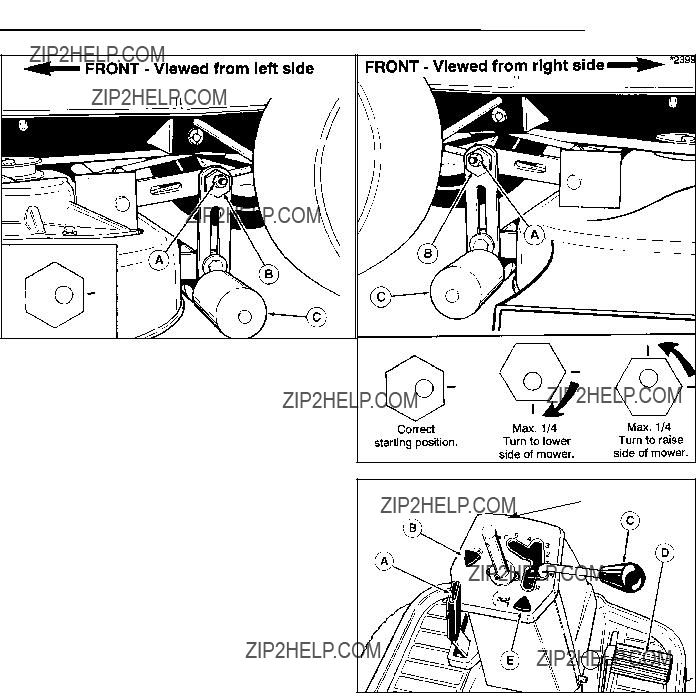
Adjustments
Figure 31. Leveling The Mower
A.Nut
B.Eccentric Nut
C.Rear Rollers
6.See figure 31. On left side of mower, make sure eccentric nut is in correct position as shown. Loosen outside nut (A) and rotate eccentric nut (B) so that flat side with hole closest to it is towards the rear. Tighten ouside nut (A) while holding eccentric nut (B).
7.On right side of mower, loosen outside nut (A). Turn eccentric nut (B) counterclockwise to raise side of mower, or clockwise to lower right hand side of mower.
NOTE: Do not turn eccentric nut more than 1/4 turn in either direction. When adjusted beyond 1/4 turn, nut will move mower in opposite direction than when starting adjustment.
8.When adjustment is correct, hold eccentric nut (B) and tighten nut (A) to 30 ft. lbs. Check measurement on both sides of mower.
*2399
*2394
F
Figure 32. Dash Controls (shown with steering wheel
27
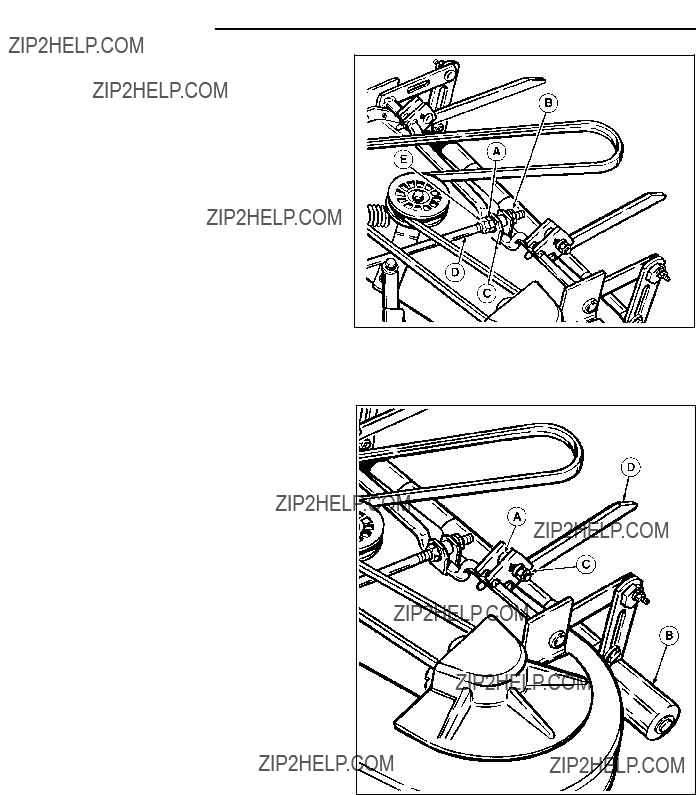
Adjustments
1.Make sure mower is level
2.Position blade(s)
On 30??? mower, the front tip should be level to 1/8??? (3 mm) higher than rear tip.
On 34??? mower, the front tips should be 1/4??? (6 mm) higher than the rear tips.
3.See figure 33. Loosen jam nut (E). To lower rear of mower deck, loosen nut (B) which will lengthen level- ing rod (D). To raise rear of deck, shorten leveling rod
(D). When proper measurement is obtained, tighten nut (A) against bracket, then tighten jam nut (E) against nut (A).
Transport Height Adjustment
Transport height should be adjusted so that rear mower rollers are 1/8??? - 1/4???
See figure 34.
1.Park rider on a flat level surface.
2.Adjust
3.Loosen nut (C) and position spacer (A) against rear trailing arms (D). Position both the left and right side spacers against trailing arms.
4.Tighten nut (C) securely.
5.Place mower lift lever in transport position. Rear mower rollers should be 1/8??? - 1/4??? off ground. If not, repeat steps 2 - 4.
Blade Brake Adjustment
Mower blades and mower drive belt should come to a complete stop within five seconds after electric PTO switch is turned off.
1.With riderin neutral, PTO disengaged and operator in seat, start the riderengine.
2.Look over the
3.If mower drive belt does not stop within five seconds, see your dealer.
*2397
Figure 33.
*2397
Figure 34. Transport Height Adjustment A. SpacersC. Nut
B. Rear Mower Rollers D. Rear Trailing Arms
28

 CAUTION
CAUTION
To avoid damaging belts, do not pry belts over pulleys.
RIDER DRIVE BELT
Replacement of the riderdrive belt requires removal of the transmission and carrier frame. Should the drive belt ever fail, contact your dealer for replacement.
MOWER BELT - 30???
See figure 35.
1.Mower does not need to be removed to install a new belt. However, for easier access, mower can be removed following steps in ???Mower Removal and Installation.
2.If mower is not removed, place mower in lowest cut- ting position. Pull idler pulley arm (A) towards you to relieve belt tension. Remove belt from idler pulley (B) and center arbor pulley (C).
3.Remove belt from front idler pulley (D) and PTO pul- ley (E).
4.Replace old belt with new belt. Make sure
(B). Check belt pattern as shown.
5.Install mower if it was removed, and install belt on PTO pulley (E).
MOWER BELT - 34???
1.Mower does not need to be removed to install a new belt. However, for easier access, mower can be removed following steps in ???Mower Removal and Installation.
2.If mower is not removed, place mower in lowest cut- ting position. Push idler pulley arm (A, figure 36) away from you to relieve belt tension. Remove belt from idler pulley (B) and PTO pulley (C).
3.Remove the three capscrews (D, figure 36) securing the
4.Remove old belt from arbor pulleys and replace with new belt. Make sure
5.Install mower if it was removed, and install belt to PTO pulley (C, figure 36). Push idler arm and install belt around idler pulley.
Belt Replacement
*2391
Figure 35. Belt Pattern - 30??? Mower
Figure 36. Mower Belt Replacement - 34???
*2392
Figure 37. Belt Pattern - 34??? Mower
29

Specifications
NOTE: Specifications are correct at time of printing and are subject to change without notice.
ENGINE
11 HP I/C ??? Briggs & Stratton
13 HP Diamond OHV ??? Briggs & Stratton
TRANSMISSION
Gear Models
Hydro Models
CONTROLS
14 HP Command??? ??? Kohler
CHASSIS
30
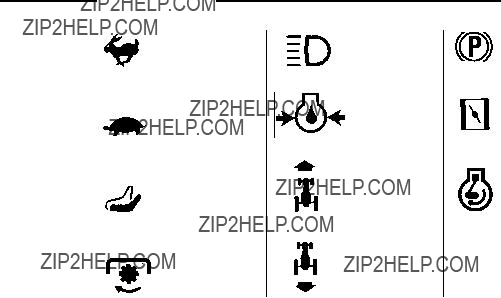
International Symbols
Parking Brake
Engine Running
31

Parts & Accessories
USE ONLY GENUINE FACTORY REPLACEMENT PARTS
Available Through Your Local Authorized Dealer.
COMMON REPLACEMENT PARTS
Listed below are the more common replacement parts. Only genuine factory replacement parts will assure optimum perfor- mance and safety. Do not attempt repairs or maintenance unless proper procedures and safety precautions are followed. For assistance in any area, see your dealer.
OPTIONAL ACCESSORIES
See your dealer to purchase these items.
MAINTENANCE ITEMS
Technical Manuals
Additional Technical Literature Available
Operators Manuals
Additional copies of this manual are available, (and as part of our product suport commitment, we maintain a stock of printed operators manuals going back many years!)
Parts Manuals
Fully illustrated parts manuals are also available ??? these manuals show all of the product???s components in exploded views (???3D??? illustra-
tions which show the relationship of the parts and how they go together), as well as giving the replacement part numbers and quantities used. Important assembly notes and special torque values are included in these manuals.
For the applicable manuals currently avail- able for your model, contact our Customer Publications Department at
Please allow 3 to 4 weeks for delivery.
Model: _______________________________________
Mfg. No.: _____________________________________
Your Name: ___________________________________
Address: _____________________________________
City, State, Zip: ________________________________
Visa/Mastercard No.: ___________________________
Card Expiration Date: __________________________
32